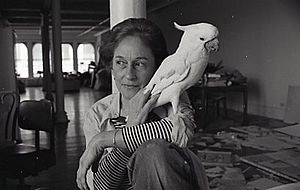Sylvia Wald facts for kids
Sylvia Wald (born October 30, 1915 – died 2011) was a talented American artist. She was born in Philadelphia and studied art at the Moore Institute of Art. Sylvia started her career painting in a style called Social Realism. Later, she became known for her Abstract Expressionism through new ways of using silkscreening and collage in her sculptures. People admired her for her "wide range of expression, different art materials, and excellent skills."
Contents
Sylvia Wald's Artistic Journey
Early Life and Art
After finishing her studies at the Moore Institute, Sylvia Wald worked as an art teacher. She taught art to elementary school children. This was part of a government program called the Works Project Administration (WPA). This program helped many people find jobs during a difficult time.
Her early artwork showed her interest in society. She painted scenes of everyday American life, especially focusing on working-class people. She shared these paintings in popular magazines of that time. In the late 1930s, Sylvia moved to New York City.
Exhibitions and New Techniques
Sylvia's art was shown in important places. In 1940, her work was part of a show at the MoMA in New York. This show was special because it aimed to sell affordable art prints to everyone. Her art was also featured in exhibitions in 1947 and 1951. These shows were organized by the National Serigraph Society.
During the 1940s and 1950s, a new art style called Abstract Expressionism became very popular in New York. Sylvia's art started to become more abstract too. She became a leader in this movement. She was especially known for her new ideas in silkscreening. She learned this technique in 1941.
Instead of using regular ink, Sylvia used oil paints for her silkscreen prints. She even brought the "action painting" style, made famous by artists like Jackson Pollock, to her textile work. She created very large pieces, some as big as 5 or 6 feet square.
Moving into Sculpture
From the 1960s onwards, Sylvia became very interested in sculpture. She especially liked making collages and assemblages. A collage is art made by gluing different materials onto a surface. An assemblage is a 3D collage, using various objects.
She often worked with paper. She experimented with it, just like she did with silkscreening. She would dye, fold, twist, and even rip the paper. She was always looking for new ways to express her ideas through art.
After her first husband passed away in 1963, and her mother a few years later, her sculptures became even more experimental. She started using many different materials. These included wire, string, bamboo, and plaster.
Legacy and Collections
Sylvia Wald later married another artist named Po Kim. Together, they created The Sylvia Wald and Po Kim Art Gallery. This is a non-profit art foundation. It is still located in their former home in New York City.
Sylvia Wald's artwork is held in many famous art collections around the world. These include:
- The Metropolitan Museum of Art in New York
- The Museum of Modern Art in New York
- The Brooklyn Museum in Brooklyn
- The Whitney Museum of American Art in New York
- The Solomon R. Guggenheim Museum in New York
- The Philadelphia Museum of Art in Philadelphia
- The National Gallery of Art in Washington D.C.
- The Victoria and Albert Museum in London, England
- The Bibliothèque Nationale in Paris, France


